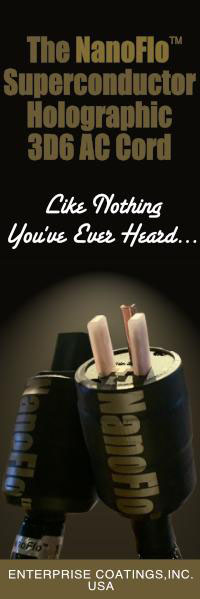In Answer to Anna Logg
| In Answer to Anna Logg |
| Commentary |
| Mike Silverton |
| September 1999 |
Contributor Anna Logg was inspired to resurrect a piece she did several years back as a reflection on my and Clement Perry’s comments regarding Ralph Glasgal’s Ambiophonics. (If you haven’t seen them, what better time?)
I applaud Anna’s faith in magic. I’ve had revelations of my own lately, both of them rather humbling for this knee-jerk skeptic. After I submitted my report on the Quantum Symphony line conditioner, the imp returned to my shoulder. Hey, Fatso, he whispered (but loudly — I am, after all, an audiophile), these silly little boxes cannot possibly be as good as you think. I arose from my sweet-spot throne, walked over to the valley in which the Symphonies nestled, i.e., between my Levinson towers, and pulled the jacks. They lay there powerless, green eyes dimmed. And — yech! phooey! — no sooner appeared a nasty layer of grime in one’s canned-sound scene. So, yes, my original comments are right on the money. And I remain in the dark. How can something to which nothing is plugged, ingoing or out (excepting the jack from the 9-volt transformer), affect house current so dramatically? When people throw about terms like quantum mechanics, I’m tempted to ask, Does this require a wrench?
Another touch of magic has naught to do with audio. My wife and I caught a medical report on NBC News one morning in which the reporter carried on about a pair of molded plastic thingies you hold in your hands when exercising. I dialed the toll-free number and wound up buying a set. I’m an enthusiastic walker who usually endures a few days of lower back pain after a strenuous hike. For some reason as incomprehensible to me (read: magical) as what one’s Quantum Symphonies do, these doohickeys work. By positioning one’s thumb in a certain way, one’s hips are in better balance. Be that as it may, I’ve taken some long, fast walks, grips in hand, and my back feels terrific. Magic! (It’s called the e3 Fitness Grip, for information about which, BioGrip, Inc., PO Box 1375, Rancho Cordova, CA 95741, phone 1 888 590 4747, and no, I get no kickback. More a question of a good thing deserving an unsolicited boost.)
In invoking magic, Anna and I are of course engaging in overkill. If something in audio (or physical activity) actually performs as advertised, there’s got to be an earthbound reason. Sometimes the audio designer — inventor, innovator — happens upon an improvement he cannot explain in terms of what, precisely, goes on. Sooner or later, however, the explanation arrives. Perhaps as a measurement no one till then knew how to take, etc., etc. I recall a conversation I had with a cable designer-manufacturer who told me quite candidly that he had difficulty understanding the physics behind differences he heard in simply reconfiguring the geometry of a given length of wire. And this guy’s no dummy.
In remaining with magic as metaphor, I offer my colleague a wand one waves to the solemn intonation of Abracadabra! and there it is: whatever one wanted. But let’s suppose that our wand is about the size of a front-lawn flagpole. Is it worth the hernia? Ralph Glasgal tells us that one needn’t go to pains quite so extraordinary as those in his vast listening space — a king’s ransom in speakers alone, and that traffic-stopping billboard-slab. Yes, I know, I’ve not heard Ralph’s latest iteration. Nevertheless, if I found the rig I listened to unimpressive vis-à-vis the effort it took to create it, I think it’s safe to surmise that a simpler installation provides a lesser yield. I need not protract this line of thought.
Bear in mind that we are not discussing true multi-channel sound. A good multi-channel recording is an astonishment. I mean, of course, a recording of acoustic-in-the-original fare, from solo piano to string quartet to jazz ensemble to grand bamboola for orchestra, chorus, soloists and organ. Indeed, yes. I’ve heard a few, and they are, as I say, a wonder. However, there’s another, much less traveled avenue of activity true multi-channel sound is bound to bring to full-blown fruition. I was for years the stuckee at Fanfare, the bi-monthly record review. Anything electronic — computer music, synthesizer music, the whole virtual enchilada — arrived at my digs sure as death and taxes. What a frustrating assignment! Here I was, listening to music as often as not screaming for another dimension in which to range about. Frequently, the discs I reviewed contained material mixed down to two channels in order to exist at all beyond the space in which it played as a concert event. I suggest that canned music’s near future offers as powerful a creative tool as the fortepiano’s appearance in its world of harpsichords. Meanwhile, there’s nothing like a good two-channel system for two-channel originals. The more effort I put into perfecting my rig, the more obvious this becomes.
![]()
Don’t forget to bookmark us! (CTRL-D)
Stereo Times Masthead
Publisher/Founder
Clement Perry
Editor
Dave Thomas
Senior Editors
Frank Alles, Mike Girardi, John Hoffman, Russell Lichter, Terry London, Moreno Mitchell, Paul Szabady, Bill Wells, Mike Wright, Stephen Yan, and Rob Dockery
Current Contributors
David Abramson, Tim Barrall, Dave Allison, Ron Cook, Lewis Dardick, Dan Secula, Don Shaulis, Greg Simmons, Eric Teh, Greg Voth, Richard Willie, Ed Van Winkle, and Rob Dockery
Music Reviewers:
Carlos Sanchez, John Jonczyk, John Sprung and Russell Lichter
Site Management Clement Perry
Ad Designer: Martin Perry





Be the first to comment on: In Answer to Anna Logg